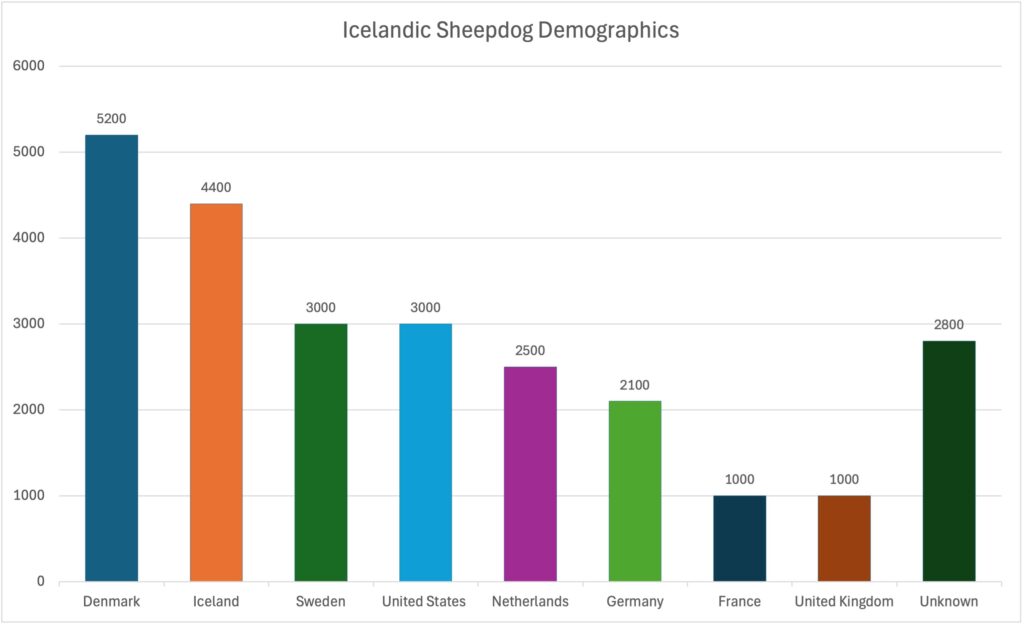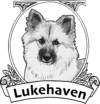Although the Icelandic Sheepdog is celebrated for its heritage and temperament, it remains one of the rarer AKC-recognized breeds. Icelandic Sheepdog demographics reveal interesting patterns about the breed’s distribution and popularity. This updated overview of Icelandic Sheepdog demographics includes fresh insights from Iceland’s new Sheepdog Heritage Center to give you the most accurate picture of the breed’s current status and trends.
1. AKC Popularity Ranking and U.S. Icelandic Sheepdog Demographics
- AKC Popularity Rank (2023): #146 out of 200+ breeds
- American Kennel Club Registration Trajectory: Since full Herding Group recognition in 2010, annual registrations have climbed gradually—but from a low base. While the demographics are growing slowly, mainstream breeds see tens of thousands of new puppies each year, whereas this breed adds only a few hundred U.S. registrations annually.
- Geographic Spread: U.S. breeders and owners are most concentrated in the Northeast, the Midwest (particularly around the Great Lakes), and parts of the Pacific Northwest. Because the breed remains uncommon, many prospective owners travel significant distances or join waiting lists to secure a litter.
Insight for Buyers: A rank of #146 underscores the breed’s rarity. If you’re considering an Icie puppy, plan ahead—expect wait times of 6–12 months, and be prepared for possible travel to a reputable breeder. Understanding Icelandic Sheepdog demographics is crucial; these challenges are part of the journey.
2. Nordic Home Base and International Distribution
Iceland
- Iceland:
- Today roughly 4,400 Icelandic Sheepdogs reside on the island.
- Cumulatively, 4,503 Sheepdogs have been registered in Iceland since formal records began in 1969 (Icelandic Kennel Club).
- Rank: 5th most-registered breed last year, with 100 puppies whelped across 21 litters—behind only more populous national breeds.
- Denmark and Sweden:
- Denmark hosts approximately 5,200 Icelandic Sheepdogs—the largest non-Icelandic population.
- Sweden follows with about 3,000 dogs, illustrating a notable distribution of Icelandic Sheepdog demographics.
- Both countries maintain active national breed clubs that oversee health programs, breeder networks, and owner education.
- Other European Countries:
- Germany (~2,150 dogs) and the Netherlands (~2,230 dogs) have growing communities supported by dedicated associations.
- The United Kingdom and France each maintain modest populations (under 1,500 dogs).
- North America:
- The U.S. and Canada together account for approximately ~3,000 registered Sheepdogs, making demographics vital for genetic diversity within the Icelandic Sheepdog population.
- Global Total:
- Approximately ~25,000 Icelandic Sheepdogs worldwide, placing the breed among the rarest AKC-recognized types in terms of demographics.

3. Popularity Trends and Cultural Impact
- Steady Growth: Coordinated efforts by the AKC Parent Club (ISAA) and the Icelandic Sheepdog International Cooperation (ISIC) have helped keep registrations stable or growing by roughly 3–5% annually in key regions.
- Media & Museum Influence:
- The May 2025 opening of Iceland’s Sheepdog Heritage Center has boosted public awareness domestically and abroad, impacting Icelandic Sheepdog demographics positively.
- Features in canine-sport journals and “unusual breed” spotlights continue to introduce Icies to wider audiences, enhancing awareness of Icelandic Sheepdog demographics.
- Genetic Conservation: In 2024, Iceland’s Agricultural Genetic Resources Committee officially designated the Sheepdog a native genetic resource, embedding it in the national conservation strategy.
5. Key Takeaways about Icelandic Sheepdog Demographics
- Expect Rarity: Plan for waitlists and travel when seeking a puppy.
- Support Clubs: Joining ISAA or your national Icelandic Sheepdog club connects you to resources, events, and reputable breeders. Engaging with Icelandic Sheepdog breed clubs can also provide deeper insights into demographics.
- Value Quality over Quantity: Small annual registration numbers reflect careful breeding—prioritize health clearances and club-recommended practices over immediate availability.
